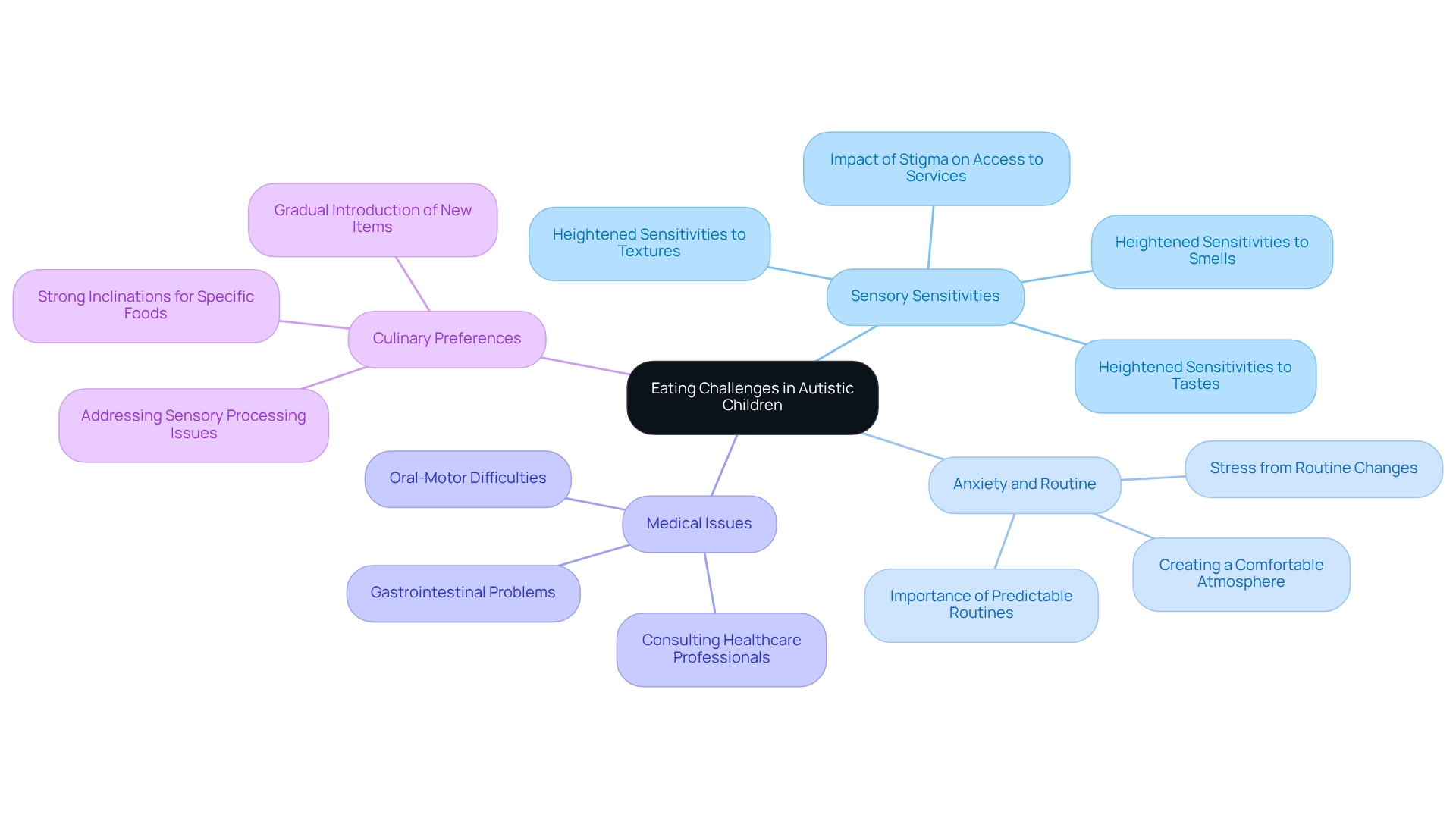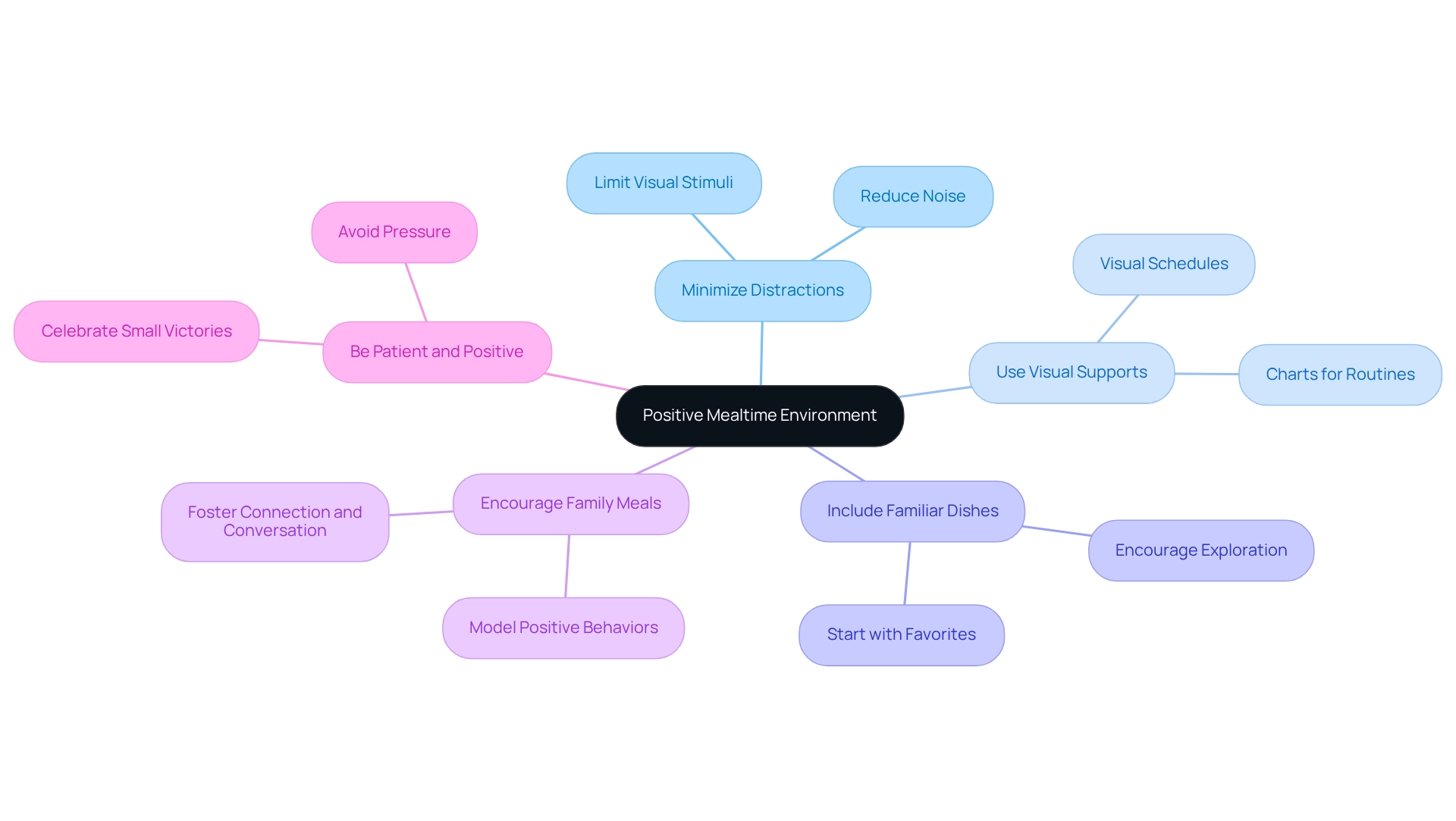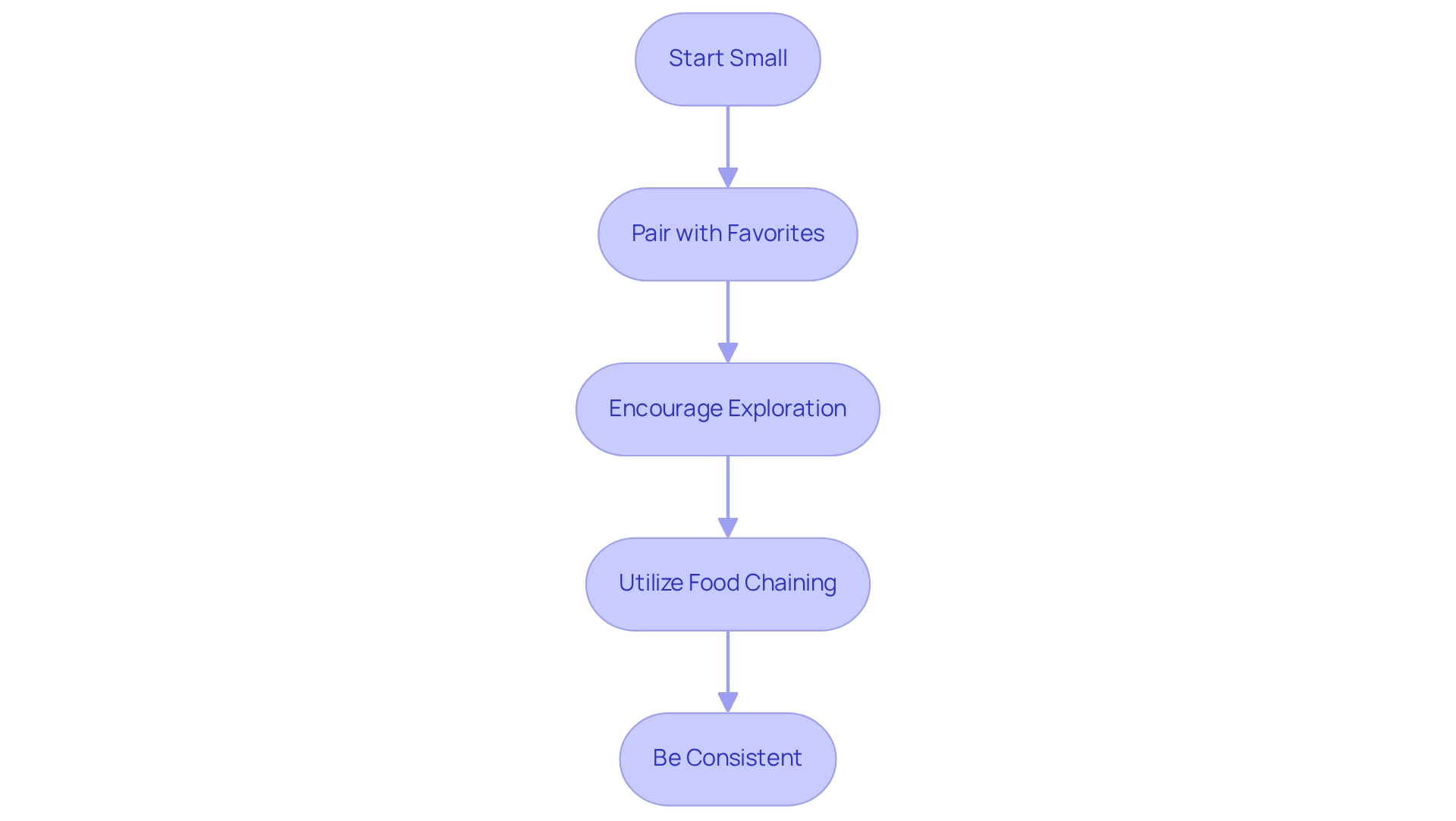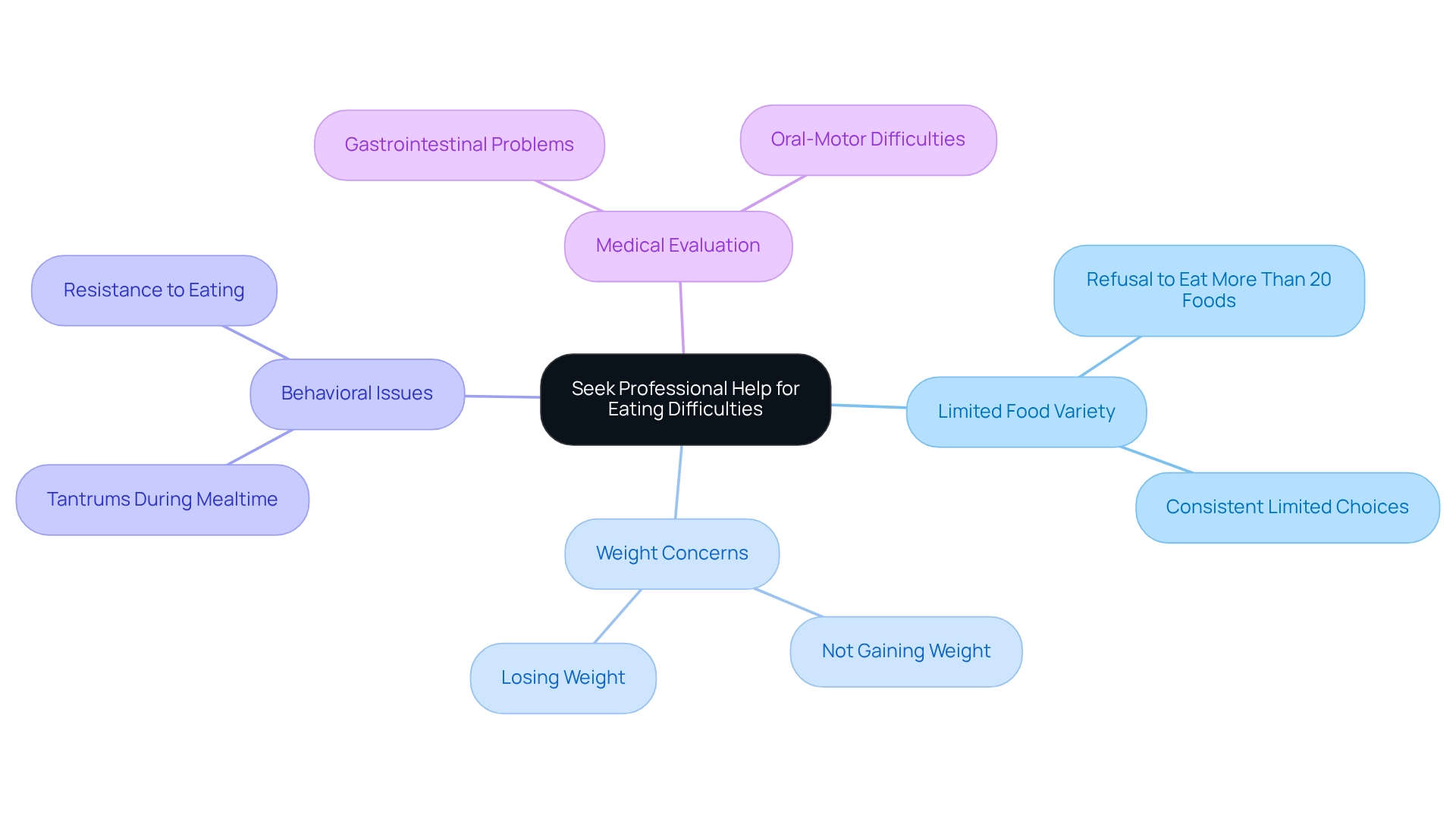Overview
This article presents four essential steps to help parents encourage their autistic child to eat. It emphasizes the importance of:
- Understanding the unique eating challenges faced by these children
- Creating a nurturing mealtime environment
- Gradually introducing new foods
- Recognizing when to seek professional assistance
Each step is enriched with insights into sensory sensitivities, the significance of routine, and the necessity for customized strategies. By adopting a compassionate and patient approach, parents can significantly enhance their child's mealtime experiences and nutritional outcomes. Remember, you are not alone in this journey; support and resources are available to help you every step of the way.
Introduction
Navigating the intricacies of mealtime can be a daunting challenge for parents of autistic children. Eating difficulties often arise from a complex interplay of sensory sensitivities, anxiety, and medical issues. Understanding these challenges is essential for fostering positive eating experiences and ensuring adequate nutrition.
By creating a supportive mealtime environment and gradually introducing new foods, families can empower themselves to tackle these hurdles effectively. Recognizing when professional intervention is necessary adds another layer of support, helping to cultivate healthier eating habits and emotional well-being.
This article explores the multifaceted reasons behind eating challenges in autistic children and offers practical solutions to enhance their mealtime experience.
Understand the Reasons Behind Eating Challenges in Autistic Children
Eating challenges in autistic children can arise from a variety of interconnected factors that parents often grapple with:
- Sensory Sensitivities: Many autistic children experience heightened sensitivities to textures, tastes, and smells. This can render certain foods unappealing or even intolerable, significantly impacting their willingness to eat. Research suggests that sensory sensitivities are common, with studies demonstrating that stigma related to autism restricts access to services, which may worsen these issues. Understanding how to get autistic child to eat can help parents approach mealtimes with greater compassion.
- Anxiety and Routine: Changes in routine or unfamiliar environments can heighten anxiety levels, making mealtimes particularly stressful. Pediatricians emphasize the importance of establishing a predictable routine to help alleviate anxiety during meals, which is crucial for parents learning how to get autistic child to eat. Consistency can create a more comfortable atmosphere, encouraging better eating habits and reducing stress for both parents and children.
- Medical Issues: Gastrointestinal problems and oral-motor difficulties are common among autistic individuals and can significantly affect their eating behaviors. Consulting with healthcare professionals is crucial to identify and address any underlying medical concerns that may be contributing to these challenges. Parents should feel empowered to seek the necessary support for their child.
- Culinary Preferences: Autistic children frequently establish strong inclinations for particular items, which can result in a restricted diet. Comprehending these preferences is crucial for parents looking to gradually introduce new items. Case studies have demonstrated that tackling sensory processing issues is essential for enhancing eating behaviors, especially concerning food textures and mealtime dynamics.
By acknowledging and comprehending these difficulties, parents can customize their approaches on how to get autistic child to eat more effectively. This understanding ultimately promotes a more positive mealtime experience, fostering not only better nutrition but also emotional well-being for both child and parent.

Create a Positive Mealtime Environment
Creating a positive mealtime environment is essential for nurturing your child's experience and learning how to get an autistic child to eat. Here are some thoughtful strategies to consider:
- Minimize Distractions: Reducing noise and visual distractions during meals can make a significant difference. Research indicates that youngsters with ASDs often face sensory processing challenges, which can complicate how to get an autistic child to eat and focus on the dining experience.
- Use Visual Supports: Implementing visual schedules or charts can help outline mealtime routines. This approach allows young individuals to understand what to expect, promoting a sense of security.
- Include Familiar Dishes: Starting meals with familiar favorites can foster a sense of safety and encourage your child to explore new foods alongside those they already enjoy.
- Encourage Family Meals: Dining together as a family not only models positive eating behaviors but also cultivates a sense of community. Use mealtimes as an opportunity for connection and conversation.
- Be Patient and Positive: Celebrate small victories with positive reinforcement, whether it's trying a new dish or sitting at the table for the entire meal. It's important to avoid pressuring your child to eat, as this can lead to resistance.
As Stephen Shore, an adult with high-functioning autism, poignantly expressed, "Carrots in a green salad and celery in tuna fish salad are still intolerable to me because of the contrast in texture between carrots or celery and salad or tuna fish is too great." This insight underscores the importance of recognizing sensory sensitivities when crafting mealtime environments.
Moreover, effectively managing food selectivity is crucial for knowing how to get an autistic child to eat, and it involves collaboration among dietitians, occupational therapists, and psychologists. Together, they can develop comprehensive strategies that address both nutritional needs and sensory sensitivities. This collaborative approach can lead to improved dietary habits and nutritional sufficiency, ultimately enhancing the health and well-being of children with ASDs.
By implementing these strategies, you can cultivate a nurturing mealtime atmosphere that supports your child's nutritional needs and emotional well-being, which is crucial for learning how to get an autistic child to eat. Ongoing research is crucial to guide strategies for dietary selectivity in youth with ASDs, highlighting the persistent challenges in this area. Together, we can work towards creating a more positive dining experience for our children.

Introduce New Foods Gradually and Effectively
Introducing new foods to your little one can be a daunting task, but learning how to get an autistic child to eat with a gentle approach can also make it a rewarding experience. Here are some caring steps to help make this process smoother:
- Start Small: Begin with tiny portions of new foods, like a pea-sized bite. This approach reduces stress and allows your child to explore the meal at their own pace, without feeling overwhelmed.
- Pair with Favorites: Serve new items alongside familiar favorites. This strategy can help the new food feel less intimidating and more acceptable, easing the transition.
- Encourage Exploration: Allow your child to touch, smell, and even play with the new item before tasting it. This sensory exploration can significantly reduce anxiety and foster curiosity.
- Utilize Food Chaining: Gradually modify a favorite item to resemble the new food. For instance, if your child enjoys mashed potatoes, consider introducing mashed cauliflower as a gentle step.
- Be Consistent: Offer the new dish multiple times without pressure. It may take several exposures before your child is ready to try it. Celebrate any willingness to engage with the meal, even if they don’t consume it right away.
By following these compassionate steps, you can discover how to get an autistic child to eat and help them develop a positive relationship with food, making mealtime a joyful experience.

Seek Professional Help When Necessary
Identifying when to seek professional assistance for your child’s eating difficulties is vital for their well-being. Recognizing the signs early can make a significant difference in their health and happiness. Here are some key indicators that may suggest the need for intervention:
- Limited Food Variety: Many autistic children exhibit a limited food variety, often refusing to eat more than 20 different foods. If your child consistently falls into this category, it may indicate a need for professional support.
- Weight Concerns: Keep a close eye on your child’s weight. If they are not gaining weight or are losing weight, it is essential to consult a healthcare provider to evaluate their nutritional intake.
- Behavioral Issues: Mealtime should not be a source of distress. If it often leads to tantrums or resistance, professionals can help identify and address underlying behavioral challenges related to how to get autistic child to eat. As one expert noted, "We offer safe spaces without judgment, where everyone is welcomed, accepted, and listened to."
- Medical Evaluation: If you suspect any medical issues, such as gastrointestinal problems or oral-motor difficulties, consulting a pediatrician or feeding specialist for a thorough assessment is advisable.
Collaborating with occupational therapists, speech therapists, or registered dietitians can provide customized strategies on how to get autistic child to eat and manage their eating difficulties. Acting promptly can lead to substantially better outcomes. For instance, initiatives like 'Feeling Strong' have shown that focused assistance can significantly enhance the welfare of youth facing distinct challenges.
By being vigilant about these signs and understanding community needs, you can ensure that your child receives the necessary support to foster healthier eating habits. Remember, you are not alone in this journey, and seeking help is a strong step towards nurturing your child's well-being.

Conclusion
Eating challenges in autistic children arise from a variety of interconnected factors, such as sensory sensitivities, anxiety, medical issues, and specific food preferences. Understanding these underlying reasons allows parents to tailor their approaches, fostering a more supportive mealtime environment. Strategies like minimizing distractions, using visual aids, incorporating familiar foods, and encouraging family meals are essential for enhancing the mealtime experience.
Introducing new foods gradually and effectively is crucial for expanding dietary variety without overwhelming the child. Techniques such as starting small, pairing new foods with favorites, and encouraging sensory exploration can make a significant difference. Additionally, recognizing when professional help is needed ensures that children receive the appropriate support to address their unique challenges, whether through nutritional guidance or therapeutic interventions.
Ultimately, fostering positive eating experiences for autistic children is a journey that requires patience, understanding, and collaboration. By implementing these strategies and remaining vigilant about potential challenges, families can empower their children to develop healthier eating habits, enhancing their overall well-being. This proactive approach not only benefits nutritional intake but also contributes to emotional health, paving the way for a more enjoyable and fulfilling mealtime experience.
Frequently Asked Questions
What are some common reasons for eating challenges in autistic children?
Eating challenges in autistic children can arise from sensory sensitivities, anxiety related to changes in routine, medical issues, and strong culinary preferences.
How do sensory sensitivities affect an autistic child's eating habits?
Many autistic children have heightened sensitivities to textures, tastes, and smells, which can make certain foods unappealing or intolerable, impacting their willingness to eat.
Why is routine important for mealtimes with autistic children?
Establishing a predictable routine can help alleviate anxiety during meals, creating a more comfortable atmosphere that encourages better eating habits.
What medical issues can affect the eating behaviors of autistic children?
Gastrointestinal problems and oral-motor difficulties are common among autistic individuals and can significantly impact their eating behaviors.
How can parents address their child's culinary preferences?
Understanding and acknowledging strong inclinations for particular food items can help parents gradually introduce new foods while considering their child's sensory processing issues.
What role do healthcare professionals play in addressing eating challenges?
Consulting with healthcare professionals is crucial for identifying and addressing any underlying medical concerns that may be contributing to eating challenges in autistic children.
How can understanding these challenges improve mealtime experiences for parents and children?
By acknowledging and comprehending the difficulties autistic children face, parents can customize their approaches to mealtime, promoting better nutrition and emotional well-being for both the child and parent.




